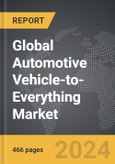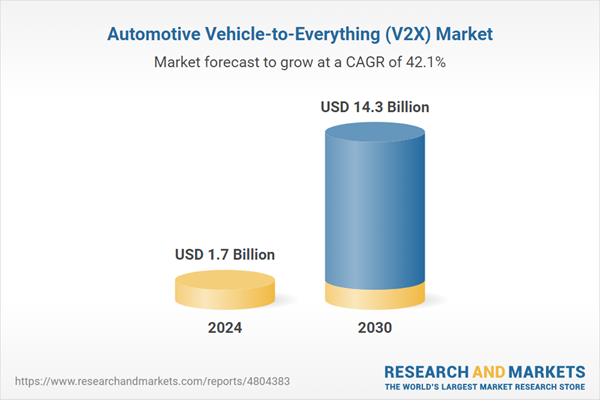Global Automotive Vehicle-to-Everything (V2X) Market - Key Trends & Drivers Summarized
Automotive Vehicle-to-Everything (V2X) technology represents a significant advancement in the realm of connected and autonomous vehicles, facilitating communication between vehicles and various elements of the transportation system. V2X encompasses several types of communications: Vehicle-to-Vehicle (V2V), Vehicle-to-Infrastructure (V2I), Vehicle-to-Pedestrian (V2P), and Vehicle-to-Network (V2N). By enabling real-time data exchange between vehicles and their surroundings, V2X enhances road safety, optimizes traffic flow, and contributes to more efficient and eco-friendly transportation systems. For instance, V2V communication allows vehicles to share information about their speed, position, and direction, helping to prevent collisions and improve overall traffic safety. V2I communication, on the other hand, connects vehicles with traffic signals and road infrastructure, providing drivers with critical information about road conditions, traffic light timings, and potential hazards.The development and deployment of V2X technology are underpinned by advancements in wireless communication technologies, such as Dedicated Short-Range Communications (DSRC) and cellular V2X (C-V2X). DSRC is a well-established technology that enables low-latency communication between vehicles and infrastructure, making it suitable for safety-critical applications. Meanwhile, C-V2X leverages the capabilities of 4G and 5G networks to offer higher data rates, greater coverage, and enhanced reliability. This dual approach ensures robust and seamless communication, accommodating the diverse needs of V2X applications. The integration of V2X technology with other emerging automotive innovations, such as advanced driver-assistance systems (ADAS) and autonomous driving, is poised to transform the driving experience. By enabling vehicles to anticipate and respond to their environment proactively, V2X contributes to the development of smarter, safer, and more connected mobility ecosystems.
The growth in the automotive V2X market is driven by several factors, including the increasing emphasis on road safety, the push for smart city initiatives, and the rapid advancements in communication technologies. Governments and regulatory bodies worldwide are recognizing the potential of V2X technology to reduce traffic accidents and fatalities, leading to supportive policies and infrastructure investments. The advent of smart cities, which rely on interconnected systems for efficient urban management, is also fueling the adoption of V2X as a critical component of intelligent transportation systems. Additionally, the continuous evolution of 5G technology is providing the necessary bandwidth and reliability for V2X applications, ensuring robust and real-time communication. Automotive manufacturers are increasingly incorporating V2X capabilities into their vehicles to enhance safety features and offer a competitive edge. As these trends continue to converge, the automotive V2X market is expected to witness substantial growth, driven by the ongoing advancements in technology and the growing demand for safer, more efficient, and connected transportation solutions.
Report Scope
The report analyzes the Automotive Vehicle-to-Everything (V2X) market, presented in terms of market value (USD). The analysis covers the key segments and geographic regions outlined below.- Segments: Offering (Software, Hardware); Propulsion Type (Internal Combustion Engine (ICE), Electric); Connectivity (Dedicated Short Range Communication (DSRC), Cellular Connectivity); Vehicle Type (Passenger Cars, Commercial Vehicles).
- Geographic Regions/Countries: World; USA; Canada; Japan; China; Europe; France; Germany; Italy; UK; Rest of Europe; Asia-Pacific; Rest of World.
Key Insights:
- Market Growth: Understand the significant growth trajectory of the V2X Software segment, which is expected to reach US$11.6 Billion by 2030 with a CAGR of 45.3%. The V2X Hardware segment is also set to grow at 32% CAGR over the analysis period.
- Regional Analysis: Gain insights into the U.S. market, valued at $533.6 Million in 2024, and China, forecasted to grow at an impressive 50.2% CAGR to reach $2.7 Billion by 2030. Discover growth trends in other key regions, including Japan, Canada, Germany, and the Asia-Pacific.
Why You Should Buy This Report:
- Detailed Market Analysis: Access a thorough analysis of the Global Automotive Vehicle-to-Everything (V2X) Market, covering all major geographic regions and market segments.
- Competitive Insights: Get an overview of the competitive landscape, including the market presence of major players across different geographies.
- Future Trends and Drivers: Understand the key trends and drivers shaping the future of the Global Automotive Vehicle-to-Everything (V2X) Market.
- Actionable Insights: Benefit from actionable insights that can help you identify new revenue opportunities and make strategic business decisions.
Key Questions Answered:
- How is the Global Automotive Vehicle-to-Everything (V2X) Market expected to evolve by 2030?
- What are the main drivers and restraints affecting the market?
- Which market segments will grow the most over the forecast period?
- How will market shares for different regions and segments change by 2030?
- Who are the leading players in the market, and what are their prospects?
Report Features:
- Comprehensive Market Data: Independent analysis of annual sales and market forecasts in US$ Million from 2024 to 2030.
- In-Depth Regional Analysis: Detailed insights into key markets, including the U.S., China, Japan, Canada, Europe, Asia-Pacific, Latin America, Middle East, and Africa.
- Company Profiles: Coverage of players such as Cisco Systems, Inc., AT&T, Inc., Capgemini SE, Audi AG, Alps Alpine Co., Ltd. and more.
- Complimentary Updates: Receive free report updates for one year to keep you informed of the latest market developments.
Some of the 89 companies featured in this Automotive Vehicle-to-Everything (V2X) market report include:
- Cisco Systems, Inc.
- AT&T, Inc.
- Capgemini SE
- Audi AG
- Alps Alpine Co., Ltd.
- Amphenol Corporation
- Bayerische Motoren Werke AG (BMW GROUP)
- Autoliv, Inc.
- Aeris Communications, Inc.
- Arm Ltd.
- Aptiv PLC
- Autotalks, Ltd.
- Cohda Wireless Pty Ltd.
- Commsignia Ltd.
- Connected Signals, Inc.
This edition integrates the latest global trade and economic shifts into comprehensive market analysis. Key updates include:
- Tariff and Trade Impact: Insights into global tariff negotiations across 180+ countries, with analysis of supply chain turbulence, sourcing disruptions, and geographic realignment. Special focus on 2025 as a pivotal year for trade tensions, including updated perspectives on the Trump-era tariffs.
- Adjusted Forecasts and Analytics: Revised global and regional market forecasts through 2030, incorporating tariff effects, economic uncertainty, and structural changes in globalization. Includes historical analysis from 2015 to 2023.
- Strategic Market Dynamics: Evaluation of revised market prospects, regional outlooks, and key economic indicators such as population and urbanization trends.
- Innovation & Technology Trends: Latest developments in product and process innovation, emerging technologies, and key industry drivers shaping the competitive landscape.
- Competitive Intelligence: Updated global market share estimates for 2025, competitive positioning of major players (Strong/Active/Niche/Trivial), and refined focus on leading global brands and core players.
- Expert Insight & Commentary: Strategic analysis from economists, trade experts, and domain specialists to contextualize market shifts and identify emerging opportunities.
Table of Contents
Companies Mentioned (Partial List)
A selection of companies mentioned in this report includes, but is not limited to:
- Cisco Systems, Inc.
- AT&T, Inc.
- Capgemini SE
- Audi AG
- Alps Alpine Co., Ltd.
- Amphenol Corporation
- Bayerische Motoren Werke AG (BMW GROUP)
- Autoliv, Inc.
- Aeris Communications, Inc.
- Arm Ltd.
- Aptiv PLC
- Autotalks, Ltd.
- Cohda Wireless Pty Ltd.
- Commsignia Ltd.
- Connected Signals, Inc.
Table Information
| Report Attribute | Details |
|---|---|
| No. of Pages | 466 |
| Published | December 2025 |
| Forecast Period | 2024 - 2030 |
| Estimated Market Value ( USD | $ 1.7 Billion |
| Forecasted Market Value ( USD | $ 14.3 Billion |
| Compound Annual Growth Rate | 42.1% |
| Regions Covered | Global |









